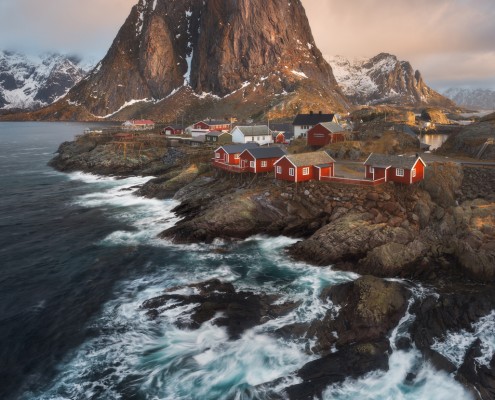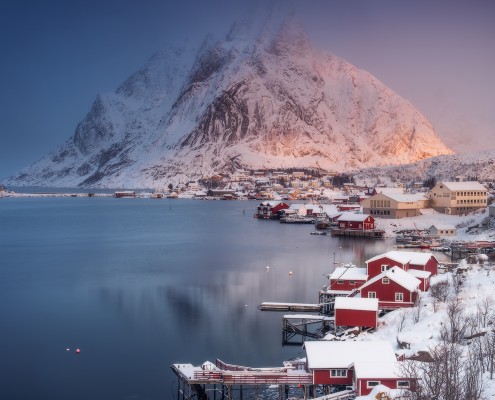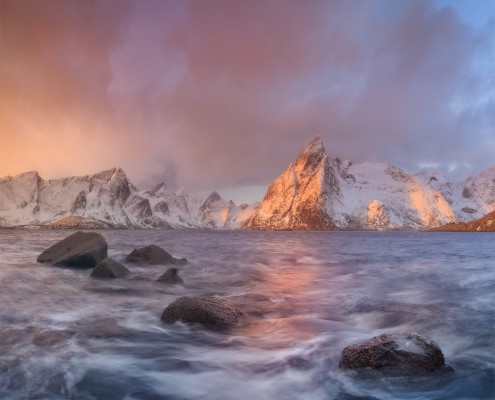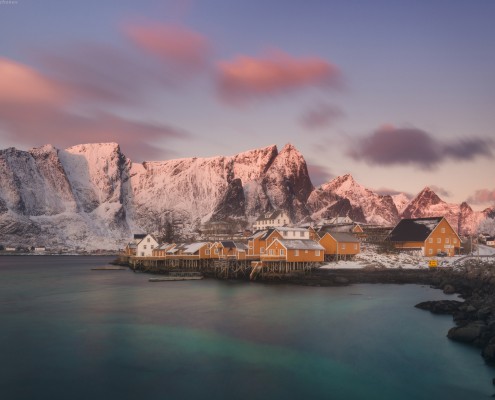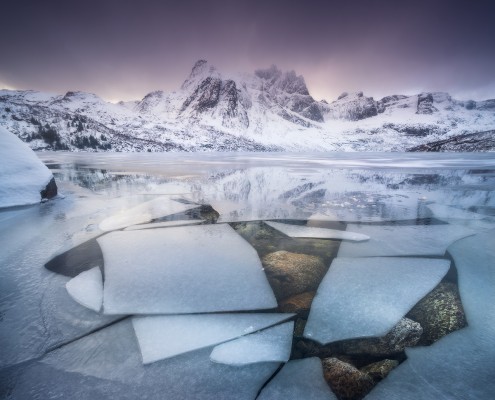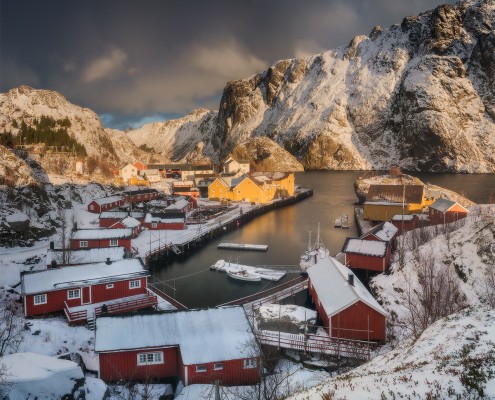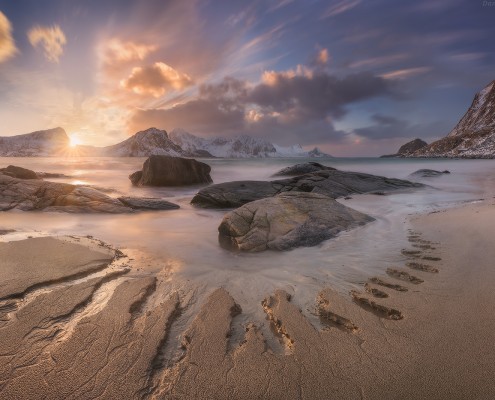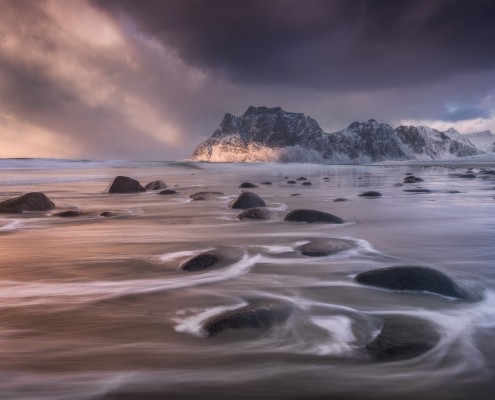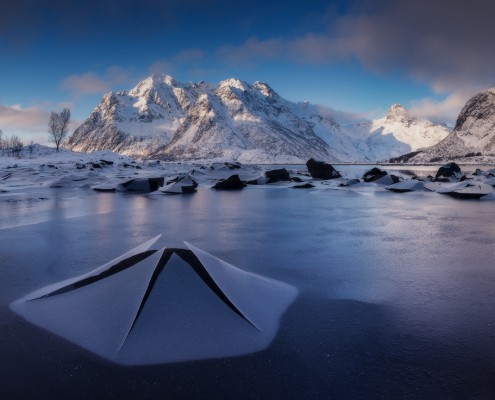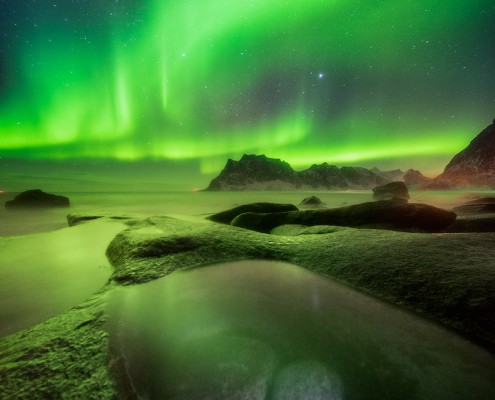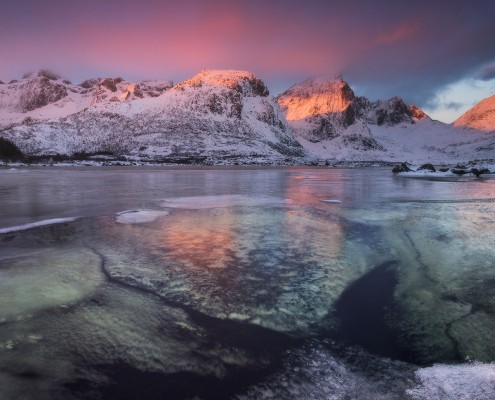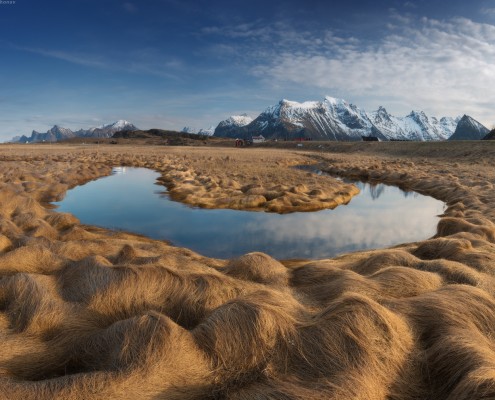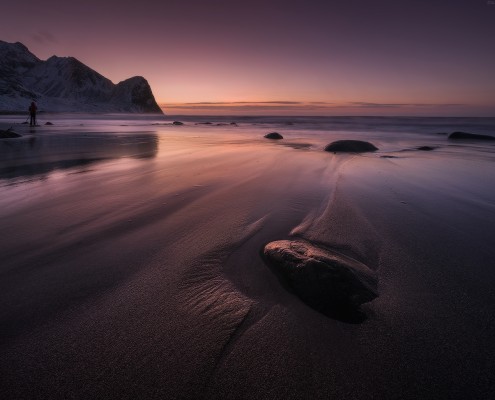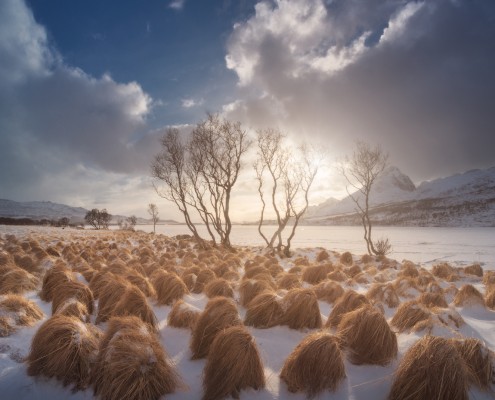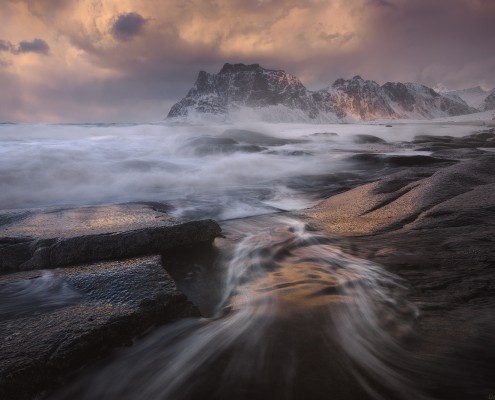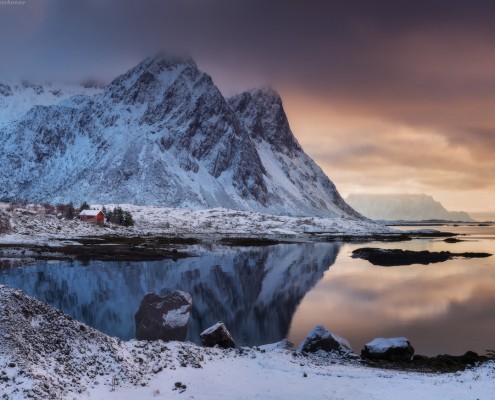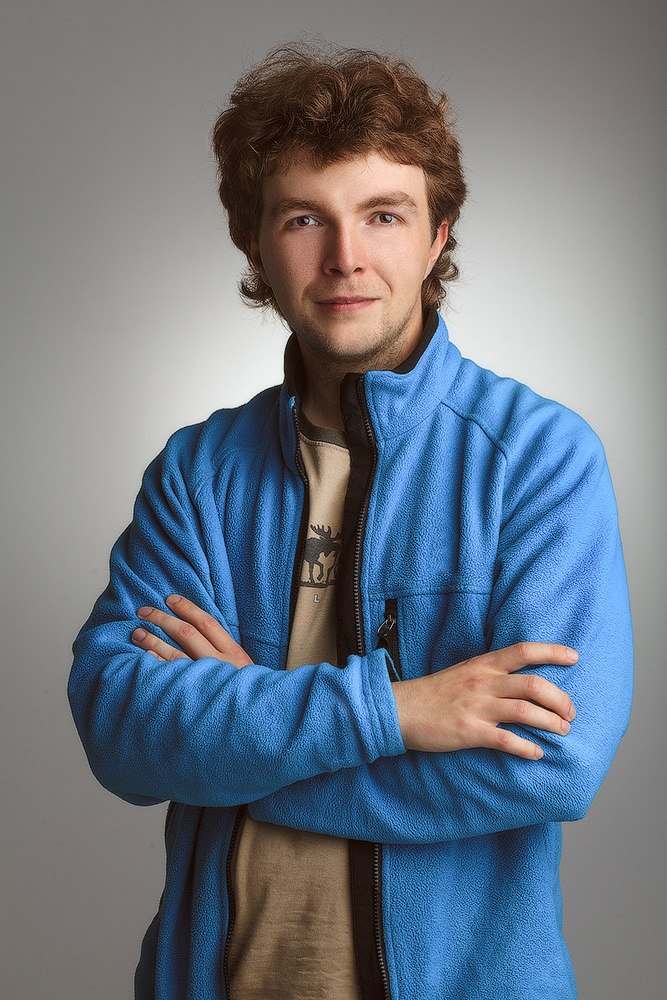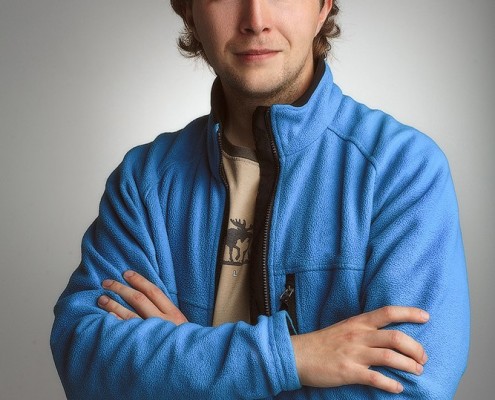The Lofotens! Imposing snowy peaks and rugged Norse fjords, whose clear turquoise water at day is no less captivating than a mighty play of the Northern Lights at night; endless long strings of bridges holding the mountains and beaches together in a unique tense construction; bright red fishing houses on poles over the water that seems to want to become ice at the first opportunity. I’m inviting you to visit this fascinating place and discover its many facets for yourselves.
For photographers and painters, the Lofotens are an endless source of inspiration, with their smallish bays, rugged coastlines, and a unique combination of turquoise water, snow-white sand and imposing mountain peaks – often all in one picture! But our primary mission, so to speak, would be the hunt for Aurora Borealis. The “Capital of Northern Lights” title may belong to Tromsø but (as every city big enough) it’s too heavily lighted at night, not to mention it doesn’t have as many interesting beaches and mountains.
Like a giant dragon, the Lofoten archipelago has stretched from the Northeast to the Southwest, surrounded by the sea from all directions. Bridges connect the individual islands, giving us full freedom of movement. That’s what makes it a photographer’s paradise: we can shoot both sunsets and sunrises from all directions, as well as stars at night and of course, the Northern Lights: there’s no light pollution to speak of! Here you can see Aurora Borealis in all its primal glory, dancing over rugged fjords and arctic beaches, and having seen it once, you’ll never forget it.
I’m so enthralled by the Lofotens that I’ve visited them six times; it’s undoubtedly one of my favorite places on Earth. I shall return there again and again, no matter how difficult the journey might be. In the winter, storms are frequent on Lofotens, and the weather can change several times within an hour – which makes shooting at the arctic beaches all the more fascinating.
Our itinerary will be based on my knowledge of the best winter viewpoints at the islands; of course, it would depend on the actual weather, and more often than not, we’d need to analyze the prognosis for several different locations before deciding on a particular place for shooting. But usually, the itinerary looks like this, with minor deviations:
Day 1
Departure to the Lofotens using recommended flight to Leknes. Please arrive at 13:00-14:00 to Leknes (flights could be bought via flysas.com with one stop in Bodo from Oslo). Once there, we’ll rent a van and drive to our rorbu cabins in Reine (the same fishing houses on poles I’ve mentioned earlier, very comfortable and warm). Then we’ll settle in and have a dinner. After that, if the solar activity and the weather window are on our side, we’ll shoot Aurora Borealis over Reine, the prettiest village on the archipelago. Our cabins can be seen on the following photos. They are clean, warm and modern inside, equipped with shower and warm floors. Everyone will have his own room and a large hall inside.
Day 2
We meet the first rays of the morning sun at the scenic overlook over Reine: from here, we have a perfect view over the Olstinden peak as well as the village itself and its bay.
After the breakfast we visit a village laconically named Å. This is a classical fishing town – a Norse Venice of sorts, with flocks of bright red rorbus here and there over the fjord. Under the snow these red houses look almost like cherries on top of a cake.
After a quick lunch we depart for a sunset/northern lights shoot at the Skagsanden beach.
Day 3
This morning, we meet the dawn on two islands near Reine – Hamnøy and Sakrisøy – trying to find the best places to shoot the first sunrays over the mountain peaks. Then, after a rest and a lunch, we’re off to Flakstad, with its snow-white coastlines and the small but unforgettable fishing village of Nusfjord, one of the oldest in the world. On the way to Nusfjord we plan to visit another stunning location – frozen Storvatnet lake with cracking ice. Sunset shoot is planned on the Uttakleiv beach, arguably one of the most impressive in the whole archipelago. Depending on the weather, we can shoot the sunset on the Vareid or Haukland beach instead: the latter is especially interesting in the winter, when the setting sun paints the snowy peaks in deep red.
Day 4
We’re shooting the sunrise from viewpoints around Reine, and after breakfast, we check out from the hotel and take a long scenic route to Leknes, driving along an old road near the eastern fjords. In cold days, when the water in the fjords freezes, the ice breaks over the stones during the low tide, forming astounding structures known as “ice flowers”.
After the sunset shoot at Uttakleiv or Unstad we arrive at Leknes and check in the local hotel. Leknes is ideal as an Aurora Borealis rapid response location: in just 20 minutes after the lights start, we can reach Uttakleiv, Haukland or Skagsanden and start shooting.
Day 5
In the morning, we’re off to a fjord near Nusfjord, to pay homage to the magnificent peaks around: the rich texture of the ice makes an excellent foreground for them. The winter sunrise paints the mountains crimson from the side. In the midday, we might visit a salty river’s wide delta and see if it isn’t frozen – if not, then we’ll be able to catch its curves with a wide-angle lens. And if there’s a lot of snow, then we’ll go to the Fredvang village with its picturesque bridges. In the evening, we’ll savor the last rays of the setting sun on the Uttakleiv, Haukland or Unstad beach.
Day 6
At dawn, we’re visiting the central part of the archipelago and shoot Henningsvær, another authentic Norse fishing village. Like Reine, it’s a picturesque rorbu settlement on an interesting coastline. Winter sunrise lights the houses and harshly-looking mountains in the background. After the shoot, we return to the Eastern part of Lofotens and meet the sunset on one of its arctic beaches.
Day 7
Morning shooting session will be on the eastern beaches or in the inner fjords with ice lakes, depending on the ice and snow conditions. In the evening, we’ll have another shoot on arctic beaches.
Day 8
Departure from Leknes airport in the morning (the tiny local airport is just 7 minutes away from the hotel by car).
Price: 3700 USD
Included in the price:
- All transfers
- Accommodation twin/double occupancy
- Instruction and master classes by professional guide
Not included in the price:
- Airfare to and from Leknes airport
- Alchogolic drinks
- meals/beaverages
- Single supplement 650 USD
Weather conditions
Lofoten islands are known for their stormy weather. If you were in Iceland, you know the thing: the climate is very similar. Although on one hand you should prepare for these conditions, on the other one stormy weather creates incredible nature scenes and sometimes can grant amazing light. The average temperature at Lofoten is about 0 C. It always balances over the zero. Sometimes the temperature may fall at -7 C (it was only one time in my life for 3 years there). But don’t relax! Winds and sea force you to feel the temperature colder. If it is zero, you may feel like -5 C or even like -10 C. So you must wear warm winter clothes (see “What to bring” section). There is a good probability of rain or snow in winter. During hard rain or snow we will make critique sessions, workshops on composition and post-processing (Lightroom, Photoshop, panorama stitching software). The schedule and locations are tentative mainly for the weather conditions. Basing on my locations knowledge I will schedule the most appropriate place for shooting according to current or predicted weather conditions.
Fitness level
All our shooting locations are easily reachable during 1 to 10 minutes from the car. We will not climb or hike on this tour. You must be prepared for winds and cold weather. Some sessions may last up to 2-3 hours with the possibility to warm up in the car from time to time.
What to bring
Lofoten islands in winter are quite comfortable to visit comparing to all places located above the polar circle. Our adventure will be quite comfortable: warm houses with hot water and modern communications like broad-band wi-fi. We will move on comfortable mini-van. But still the weater may be windy and chilling. So please bring the following gear and wear to our Lofoten photo-workshop:
Wear
• comfortable clothing. Its better to take several items using the “onion-principle”. If you are getting colder then you can put on another layer. If you are moving fast at location – then you can take one layer off.
• waterproof jacket and pants. If it is snowing or raining a little bit we may still be in the fielnds, so the upper layer must be waterproof.
• warm jacket
(better to take the synthetic filling: the humidity is quite high)
• waterproof boots: we have lots of sessions along amazing white sends arctic shorelines of Lofoten
• waterproof wellingtons (or fishermen shoes) with the length up your knees. We have lots of sea shooting, even with Northern Aurora. You can hardly get amazing photos without interacting with the sea
• warm hat
and glothes (better to take glothes with “touch-screen finger” that will allow you to set up your camera and lenses easily)
• casual clothing for the hotel stay
• soft protector to kneel. We have to shoot from low points a lot
Gear
• camera equipment (DSLR with manual control of
shutter speed, aperture and ISO settings and allowing you to use Live View). All marks of camera are welcome: I have experience to work almost with every brand, so you may always rely on my help with camera settings.
Please bring extra batteries: they can deplet fast during the night shooting.
• lenses: the most needed lens is 16-35 or 17-40 (fullframe). You may use ordinary circular or square filters with these lenses. Althought 14 mm (or 14-24 mm) lenses are very useful especially for northern lights shooting. You may use the tele-lens to capture birds in the frame or make pictures with the scale, comparing visually mountains and small cherry-like houses of Lofoten.
• headlamp with extra batteries. We should hunt the Northern Aurora at nights, so you need flashlight to move. Although notice that we have “no light polution policy” to be polite for other photographers.
• sturdy tripod that will endure Lofoten winds. I recommend ballheads with Arca Swiss system and L-plate mounting
• remote cable shutter release
• laptop for editing with software: Lightroom and optionally – Photoshop
• filters. Shooting at the sea means you should properly work with the shutter speed. Filters like ND, polarizer will help you to manage forms and colors of waves.
• chargers, spare CF/SD cards
Tour leaders
Daniel Kordan
I studied in Moscow institute of Physics and Technology and became an optics physicist. During the study he gain experience not only in physics, but also in mountain climbing and hiking, guiding tourist groups in winter and in summer in Russian mountains. Right after graduation he became a guide of photo-workshops and chief editor of “Continent expedition” magazine. This magazine is about travel and adventures all over the world. He has got several awards in photography: Golden Turtle’ 13 Nature nomination winner, National Geographic Russia contest 2013 and 2014 finalist, Best of Russia’13 and ’14 winner, best photographer’13 finalist and others. He is spending most of his time in Norway, Lofoten islands and in Tuscany at villa Gaia, guiding groups of photographers. Daniel has pulications in such mahazines as Digital SLR Magazine, UK, Photography week, Photography Master Class, National Geographic, Discovery, Photoworld China, Digital Photo (Bauer Media) magazines. Daniel is official Nikon ambassador.


